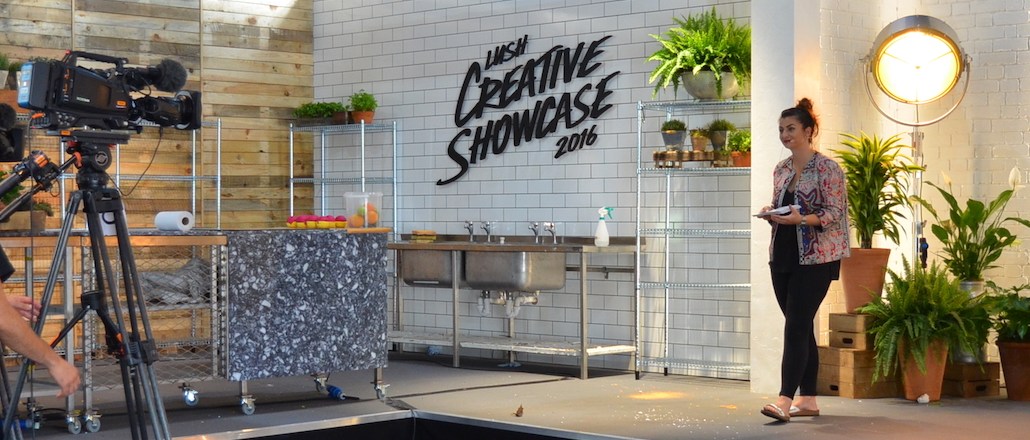Save 50% on a 3-month Digiday+ membership. Ends Dec 5.

Last week, Lush Cosmetics held its creative showcase. The quarterly unveiling of new products is usually limited to staff, but this time the two-day festival opened up to the public too. And this wasn’t the only change. Unlike other meetings, it featured seven film crews. Over two days, they fed Lush’s new app and online player with non-stop video content.
Much like a TV channel, the chat show-style broadcast featured staff “compounders,” basically makeup mixologists, making shower gels in its swanky kitchen studio, and roving reporters interviewing excitable attendees about their bath bombs.
As chief digital officer Jack Constantine explains, the showcase was a “live beta test” for Lush’s bigger plan: to launch its very own 24/7 video channel, Lush TV. The broadcast hub is planned to open in “early 2017” following the company’s move to a new office in London’s Beak Street. The company plans to build out its team with more production staff, though the final headcount is still being hammered out.
“We need to build a lot around getting that TV component right,” Constantine said.
Lush TV already exists as an online portal where staff can find how-to’s and staff meetings on-demand. However, Lush wants to create a public channel to engage its growing online audience and house all of its content in one place. “End to end, there are so many things we capture,” said Constantine. “We’re not far off being able to fill a TV channel.”
Lush already produces in-house content across video, print and digital. Its 10-strong editorial team produce “long-form” projects like documentaries and investigative projects in its print magazine, the Lush Times. Its daily team, also around 10 people, produces shorter content that mostly sits on its social channels.
“Yes, we sell products, but we can be a reliable source of news, too. We’re deep in the grassroots and care about causes like animal testing,” Constantine said.
The Lush TV channel would mix its existing content to fit audience habits at the different times of day. For example, mornings would include shorter two-minute clips to suit commuters, mid-afternoon would have content that can be viewed without sound (i.e., during work), and evenings would showcase Lush’s longer documentaries like The Fox Project.
The move to video content all started with its experimental offshoot, Lush Kitchen. The online shop ships out fresh, limited-run products to “Lushies” that they can’t find anywhere else. It has found success on social media (even eclipsing Lush’s own following) by essentially making cosmetic porn. The internet has a big appetite for satisfying ‘making-of’ content.
Without the pressure of a main channel, the team experimented with Facebook Live and Snapchat content. Here, they found a winning formula for live content — switching Q&As “which got boring very quickly” to a chat show format similar to BBC’s Saturday Kitchen.
Products like the Ro’s Argon soap sold out during these live streams. Here, viewers get the first look at new products and also explore the brand behind the scenes. The Lush Kitchen team — a manager, photographer, videographer and writer — have now been brought into the main brand. And Lush is taking these learnings with it in its wider push for live video.
“Since April, it has gone from little hand-held Facebook stream to this massive event with seven crews live streaming over the internet,” explained Colette Mounsey, who managed Lush Kitchen’s social content.
As for Lush Kitchen, the team is making everything interactive — using the hashtag #LushLive to feed in audience questions or to guide the tour according to where viewers wanted to go. Mounsey’s impromptu stream from the last week’s event — which was guided by commenters’ suggestions — has racked up 26,000 views on the brand’s main U.K. Facebook page. Despite being one of the “shaky cam” videos, this is the second-highest view count for its Facebook Live videos so far.
Against a backdrop of brightly colored bubbles and jellies, Constantine explained his message to staff:
“We just said go and catch whatever you want. There are no embargoes; it’s a free for all. The release, when you do that, is so good.”
More in Marketing

In Graphic Detail: Here’s what the creator economy is expected to look like in 2026
Digiday has charted its expected revenue, key platforms for creator content as well as what types of creators brands want to work with.

Ulta, Best Buy and Adidas dominate AI holiday shopping mentions
The brands that are seeing the biggest boost from this shift in consumer behavior are some of the biggest retailers.

Future of Marketing Briefing: AI confuses marketers but their own uncertainty runs deeper
That was the undercurrent at this week’s Digiday Programmatic Marketing Summit in New Orleans.





